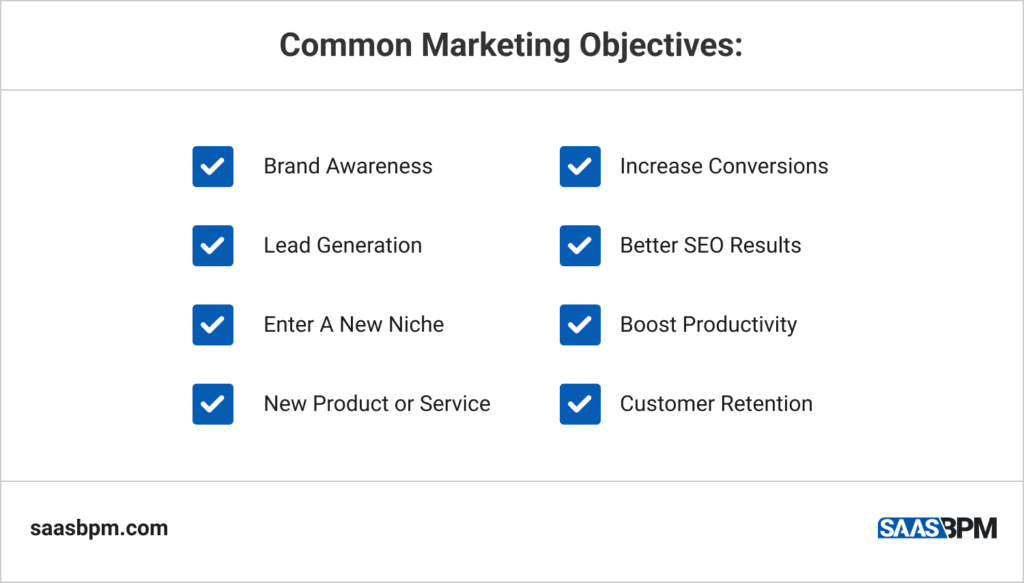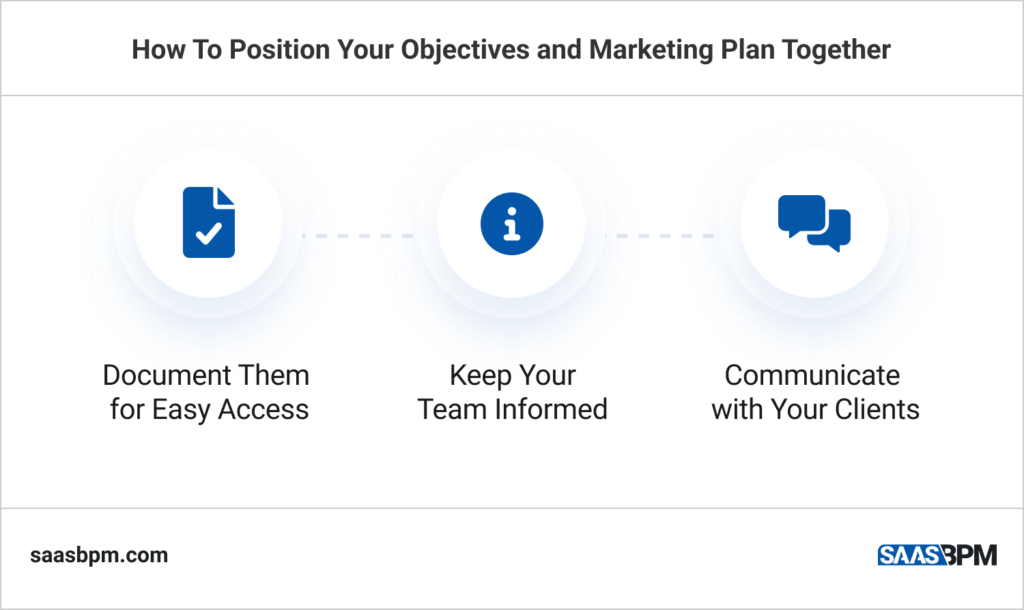When you position your objectives and marketing plan together, it’s easier to stay the course when things get challenging (as they always do). With clear, measurable goals you can avoid getting sidetracked by distractions. As a result, you’d be able to make decisions that are in line with your overall business strategy. Also, having buy-in from your team and executive leadership is critical to success. It’s all too easy for marketing goals to get overlooked when there isn’t support from the top. So, take the time to align your plan with company objectives from the start, and you can set yourself up for success.
However, there is no simple way to position your objectives and marketing plan together and stay aligned with the initial plan along the way. Often you and your team will have to tweak different aspects and discuss them with other departments and the client. Make sure you identify your target market and what solutions they seek. Then, develop a clear and concise message that appeals to your audience. And lastly, build a strategy for evaluating the results and measuring KPIs closely.
In this article, we will take a closer look at the process of defining your marketing objectives and identifying the KPIs that help achieve them. Also, we will explore the characteristics of a good marketing plan, and ways to position your objectives and marketing plan together.
How To Identify Your Marketing Objectives and KPIs?

Marketing Objectives
Clear objectives are a key part of any marketing strategy. Without well-defined goals, a brand will struggle to achieve its plans, because it won’t be clear on the steps necessary for the end result. A simple outline is required to know what you and your team aspire to and what to do to get there. When we examine the finer details of what comprises a successful ad, though, there’s no need to be concerned. Consider this scenario: you want to increase brand recognition. You’ll need to think about which marketing channels you’ll employ to reach your target audience in order for it to be effective. You’ll also need to set a budget and establish a deadline for your goal. Once you’ve determined your marketing objectives, you may then develop a marketing plan and create campaigns that can help you meet them.
While there are many goals you can outline in your marketing plan, there are some frequently used marketing objectives examples. Consider the stage and position of your brand, and select two or three marketing objectives to focus on. For example, if you’re a small business just starting out, your goal might be to build brand awareness. If you have an established brand, your goal might be to increase brand loyalty or to enter a new market. Once you’ve selected your goals, you can begin to develop your marketing strategy. Keep in mind that you need to apply SMART goals: specific, measurable, attainable, relevant, and time-bound. By sticking to these guidelines, you can create a marketing plan that will help you achieve your desired results.

KPIs
Successful goal setting in marketing requires pairing objectives with key performance indicators (KPIs) and benchmarks. This ensures that you can monitor the progress you’ve made so far and results can be fairly assessed at the end of a campaign. KPIs, as you may know, are crucial for any marketing strategy. They provide insights into how well your marketing approach is doing in terms of its goals. Therefore, it’s critical to pick metrics that are relevant to your objectives. A relevant KPI might be the total number of brand mentions on social media if your aim is to enhance brand recognition.
Once you’ve assigned KPIs to your objectives, you can set benchmarks against which you can measure progress. This way, you can check whether you’re on track to achieve your goals, and spot any warning signs in time if progress starts to stall. It would be nearly impossible to assess the effectiveness of your marketing efforts if you don’t have KPIs and targets. So, goal setting without them is simply not an option.
The Importance of A Good Marketing Plan
A marketing plan is the means through which you position your objectives and marketing activities together. The goal of a marketing campaign is to support the success of your organization’s business goals. Marketing campaigns are typically designed to achieve a particular objective or set of objectives within a specified time frame.

To be successful, your marketing plan must be aligned with your overall business strategy. It should also be structured in a way that allows you to track progress and measure results. By taking the time to develop a comprehensive and well-executed marketing campaign plan, you can position your business for success.
Marketing is the engine that drives businesses forward. Without it, companies will never be able to achieve their desired outcomes and grow sustainably!
The marketing plan ensures all processes happen on time with target audiences through appropriate channels. This includes connecting the strategic direction of the business with results delivered in an effective way so they can both thrive together as one entity.
An effective marketing strategy considers a company’s assets and limitations, as well as prospects and threats in the market. It will also consider target consumers’ demands and preferences, as well as available resources. In addition, a solid marketing plan serves as a guide to success by establishing clear objectives and goals, as well as a detailed roadmap for achieving them.
Without a doubt, a good marketing plan is an essential tool for any business that wants to succeed in today’s competitive marketplace. By taking the time to develop a comprehensive and well-thought-out plan, you can ensure that you position your next campaign for success.
3 Ways To Position Your Objectives and Marketing Plan Together
So, we’ve explained how to define your marketing objectives and the KPIs to assess them.
As you move forward with crafting your marketing plan, it is essential to keep your objectives and KPIs at the forefront of your mind. Without a clear understanding of what you hope to achieve, it will be difficult to create an effective plan. Once you have defined your objectives, take some time to consider how they fit into the overall picture. What role do they play in your company’s strategy? Additionally, by placing your goals within the context of your overall outline, you will be able to more easily track and assess your progress. So, here are 3 surefire ways to motivate your team to position your objectives and marketing plan together effectively:

Put Everything In Writing
So, the managers have agreed upon the marketing objectives and the overall marketing plan. Now it’s time to communicate all the info to your team. Make sure to do this as early as you can so your staff can take them into account immediately and channel their energy where necessary.
A good way to make sure the important details are available for everyone is to put them in writing. Surely you have a weekly/monthly/quarterly newsletter where you can effectively pass on the new marketing strategy and plan! Also, include your marketing objectives and KPIs in the employee handbook. This way, your new starters will familiarize themselves with the fundamental concepts as part of their onboarding process. As a result, they will incorporate them into their further tasks and activities.
Keep Your Team In The Loop
In order to maintain a competitive advantage, any company must make decisions swiftly and effectively. However, this does not imply that managers should always act alone. In fact, keeping your team informed may have several benefits. For one thing, it can help you think outside the box when you position your objectives and marketing plan together. Staff members also frequently have unique insights into the viability of different options and might contribute ideas you haven’t been able to think of.
Involving your team in decision-making can also help to build morale and commitment. Team members will feel that their opinions are valued and that they have a stake in the success of the business. Ultimately, involving your team in the decision-making process is likely to lead to better decisions and a more cohesive and motivated office.
Discuss Any Changes with Your Clients

When working on your marketing strategy, it is fundamental to communicate decisions and changes with your clients on a regular basis. Despite the obvious benefits like client trust and transparency of your relationship, it is also a good reality check for you in case there are details you miss out on.
Maintaining a good client relationship is dependent on positive customer communication. Customers are more likely to maintain loyalty if they feel comfortable communicating openly with a company. Furthermore, effective communication may help prevent misunderstanding and increase client happiness. Thus, clients will be more inclined to recommend a company to others.
How to Position Your Objectives and Marketing Plan Together: Final Thoughts
As you can see, there are a few different ways to position your objectives and marketing plan together. Whichever way you choose, it’s important to make your goals as clear and accessible as you can. Also, keep your team in the loop and discuss any changes with your clients. And if you need help tracking the business processes in your team or optimizing them, we at SaaS BPM are here to help.

